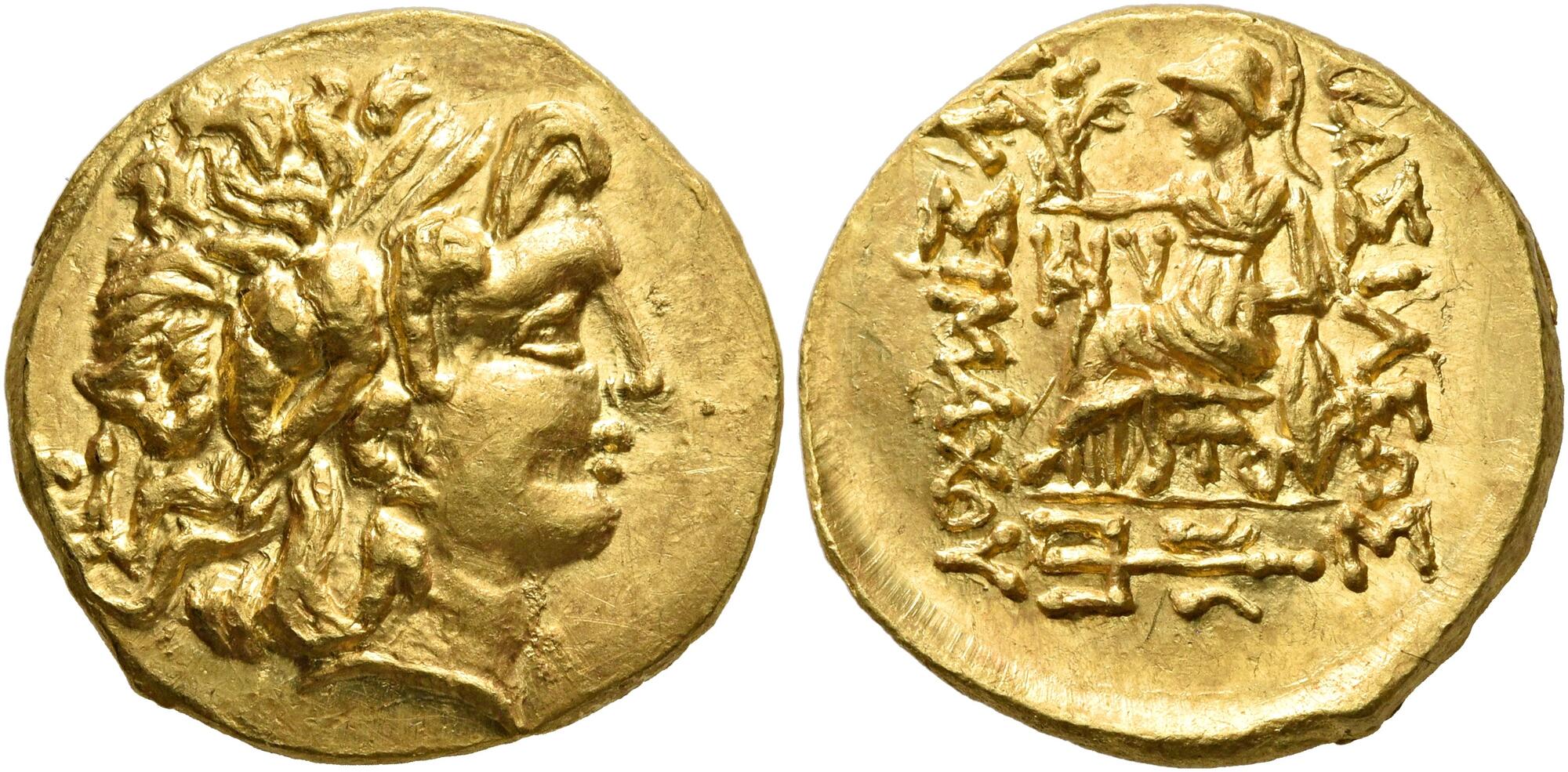Tomis, gold, staters (types of Lysimachus) (110-72 BCE)
From SILVER
110 BCE - 72 BCE Gold 12,101 kg
Description
| ObverseInscription or printing placed on the obverse.: | Diademed head of Alexander the Great to right, with horn of Ammon over his ear |
| ReverseInscription or printing placed on the reverse.: | ΒΑΣΙΛΕΩΣ ΛΥΣΙMΑΧΟΥ (Greek).Athena seated left, holding Nike, crowning the king's name, in her right hand and leaning with her left arm on shield decorated with lion's head, in inner left field, monogram of HΔ and Y, below throne, TO, in exergue, ornate trident to left |
Mint and issuing power
| MintIdentifies the place of manufacture or issue of a numismatic object.: | Tomis | Ancient regionAncient region.: | Thrace | Modern countryModern country: Romania | AuthorityIdentifies the issuing power. The authority can be "pretended" when the name or the portrait of X is on the coin but he/she was not the issuing power. It can also be "uncertain" when there is no mention of X on the coin but he/she was the issuing power according to the historical sources: | Lysimachus (Macedonian officer, diadochus and king, c. 360-281 BC) |
Chronology
| FromIdentifies the initial date in a range assigned in a numismatic context. | 110 BCE | toIdentifies the final date in a range assigned in a numismatic context.. | 72 BCE | PeriodTime period of the numismatic object.: Hellenistic 323-30 BC |
Physical description
| MetalThe physical material (usually metal) from which an object is made.: | Gold |
Median weightMedian of the weights of numismatic objects (in grams). in grams | 8.30 | DenominationTerm indicating the value of a numismatic object. Examples: tetradrachm, chalkous, denarius.: | stater |
StandardStandard.: | Attic |
Image

RQEMH 59 - Tomis, gold, stater, 110-72 BC.jpg [1]
References
| Die study referencePublication of the study: | Callataÿ 19951Callataÿ 1995, Callataÿ 1997a2Callataÿ 1997a | ||
| Coin series referenceReference to coin series study: | RQEMH3RQEMH, n° 59, HGC 3.24HGC 3.2, n° 1931 | ||
Obverse dies distribution
Reverse dies distribution
no distribution is available
Quantification
| Number of obversesNumber of obverse dies. ᵖ (o) | 7 | Number of singletons (o1)The number of singleton coins. ᵖ | 2 |
| Number of reverse diesNumber of reverse dies. (r) | 14 | Number of coinsNumber of coins. (n) | 54 |
| Coins per obverse dieNumber of coins per obverse die. (n/o) | 7.71 | Coins per reverse dieNumber of coins per reverse die. (n/r) | 3.86 |
| Reverse per obverse ratioRatio of obverse dies divided by reverse dies. (r/o) | 2 | Percentage of singletons (o1)number of coins (n) divided by the number of singletons (o1) ᵖ | 28.57 % |
| Original number of dies (O) (Carter 1983 formula)The estimation of the number of coins according to Carter 1983 ᵖ | 7.29 | Coins struck if 20,000 as average productivity per dieCoins made if the average productivity for obverses (according to Carter) is 20,000. ᵖ | 145,800 |
| Original number of dies (O) (Esty 2011 formula)The estimation of the number of coins according to the singleton formula in Esty 2011 ᵖ (O) | 8.04 | Survival rate if 20,000 as average productivity per dieSurvival rate if average productivity is 20,000. ᵖ | 0.00037 |
| Coverage (o = % of O) (Esty 1984 formula)Esty 1984 - coverage (% of O) ᵖ (o = % of O) | 96.3% | Die productivity if survival rate 1/2,000Average productivity if survival rate is 1/2,000. ᵖ | 14,814.81 |
| Weight of silver (in kg) if 20,000 coins per die (O = Carter formula)Carter 1983 * Median weight * 20000 (*10 if gold or electrum) ᵖ | 12,101 kg <br /> 12,101 kg | Die productivity if survival rate 1/5,000Average productivity if survival rate is 1/5,000. ᵖ | 37,037.04 |
Remarks
Most likely one single workstation
References
- ^ Callataÿ, François de (1995), "Les derniers statères posthumes de Lysimaque émis à Istros, Tomis et Callatis", in Numismatic and Sphragistic Contributions to Ancient and Medieval History of Dobroudja. International Symposium. Dobrich/1993 = Dobroudja, 12, p. 39-50.
- ^ Callataÿ, François de (1997), L'histoire des guerres mithridatiques vue par les monnaies, Numismatica Lovaniensia 18, Louvain-la-Neuve, XIII + 481 p. et 54 pl.
- ^ Callataÿ, François de (1997), Recueil quantitatif des émissions monétaires hellénistiques, Numismatique Romaine, Wetteren, X + 341 p.
- ^ Hoover, Oliver D. (2017), Handbook of Coins of Macedon and Its Neighbors. 3. Part 2: Thrace, Skythia, and Taurike, Sixth to First Centuries BC, Lancaster-London, xix, 232 p.